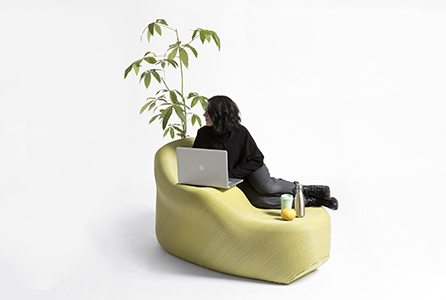Print Your City is an initiative that encourages the public to bring in their plastic waste to help redesign public spaces, by introducing its first zero waste lab in Thessaloniki, Greece.
The idea was conceived by Dutch-based research and design studio, The New Raw, with the aim of 3D printing street furniture using plastic household waste, in a bid to utilise single-use plastics to create something that will last forever.
The lab, equipped with a robotic arm and recycling facilities, invites citizens to come and learn about how plastic is recycled, read about the circular economy, and design items of furniture that would appear in their neighbourhoods. Once the design is complete, the Print Your City website works out how much plastic waste will be required to generate enough raw material for the 3D printing process.

The furniture can feature plant pots and bike racks to make them more useful in public spaces. Photo: Stefanos Tsakiris
“Plastic has a design failure. It is designed to last forever, but often we use it once and then throw it away. With Print Your City, we endeavour to show a better way of using plastic in long lasting and high value applications,” say Panos Sakkas and Foteini Setaki, founders of The New Raw.
Since the website was launched in December 2018, more than 3,000 designs have been submitted. Starting from this month, Hanth Park in Thessaloniki has been selected as the first public space to permanently host furniture from the Print Your City project.
The New Raw aims to recycle four tonnes of plastic waste during the project – about the same amount produced by 14 family households in Greece.
Prototypes for the project were first printed in the summer of 2018 and temporarily displayed on Nea Paralia, the main waterfront promenade in Thessaloniki. At this point, it took around 12 hours to print an average of 100kg of plastic into a pot, so developers decided to improve the quality of materials used in order to reduce production times.
Sakkas and Setaki add: "We started from the observation that we live in a growing society; consuming a lot of resources and generating enormous amounts of plastic waste. With the project of Print Your City, we wanted to show a better way for using plastic in long-lasting and easy-to-trace applications.

Plastic has a design failure. It is designed to last forever, but often we use it once and then throw it away”
“By using digital design and fabrication, it is possible to add value to the discarded material and make the circular concept feasible.”
The scheme is being implemented by Coca Cola in Greece in co-operation with the Municipality of Thessloniki, Ecorec and Ogilvy Greece.
The question of whether 3D printing is a sustainable means of production is a contested one, due to the amount of plastic waste produced in the process as well as the emissions caused by the high-energy 3D printers.
PLA, the most popular material used in 3D printing, is derived from renewable resources such as corn starch or sugar cane and is biodegradable under the right conditions.
With the development of recycled materials to be used in 3D printing, it could prove to be an innovative way of reusing materials that would otherwise contribute to landfill. As the technology becomes more affordable, it is being used to pioneer new ways of thinking and manufacturing.
Could recycled materials be used across all commercial 3D print? Email your comments to summer@linkpublishing.co.uk or follow us on Twitter to have your say.